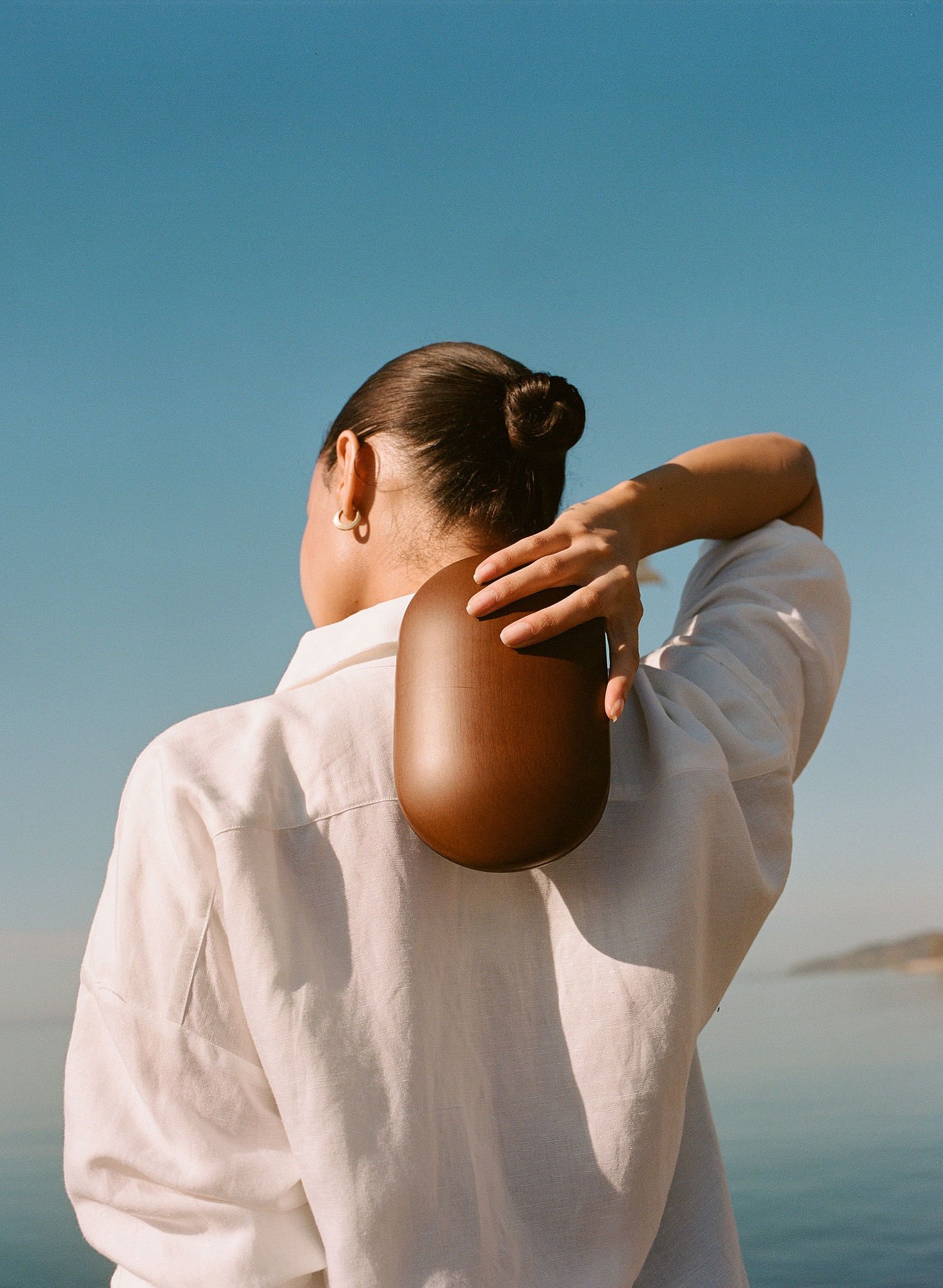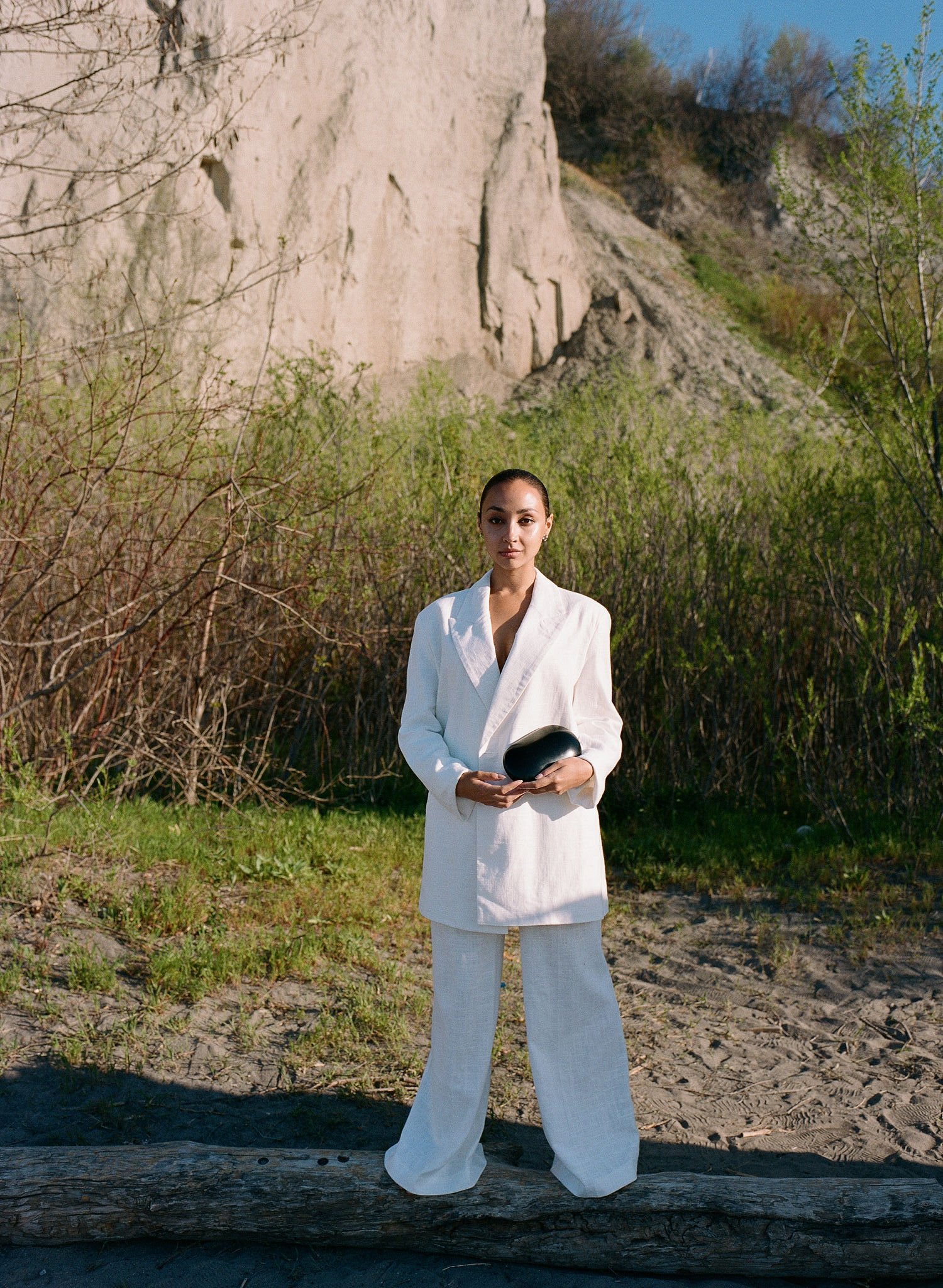The Return of Atelier MBOKA
International development expert Tina Mbachu has a long history of working with artisans across Africa. From the North, South, East… she has roamed the continent, with social enterprises to create economic opportunities for vulnerable women and youth. The informal economy has no secret for this gender equality advocate. Faced with ingenuity, creativity, and impact, as well as the tremendous challenges curbing artisans’ growth right now - she has seen it all and has been left inspired.
Starting with A Few Good Things, an online platform she created to sell the crafts of some of the talented artisans’ she had come across, Tina pushed her own boundaries going back to a project she conceptualised years ago: Atelier MBOKA, a platform re-envisioning product development through impact and her love for materials. After a successful test launch in 2017 with their signature Azita wooden clutch bag, followed by years of product testing and COVID uncertainty, Atelier Mboka is back this year with a new business vision centred on an inclusive value chain, and building a virtual factory platform to change the future of work for artisans.
In this conversation, the Canada-based founder discusses her new business approach and the intentionality behind her brand.
First, could you take us through the early days of Atelier Mboka?
My journey with Atelier MBOKA started between 2015 and 2017 when I was living and working with weaver artisans in Eswatini. I was helping two social enterprises to organise these various individual women artisans that they were working with into producer associations. Bringing those women together meant increasing their production capacity, their ability to take substantial orders volumes, and therefore, getting more opportunities to improve their income. Being there exposed me to a lot of creativity. But one problem kept coming up as I interacted with the weavers: they could not sell the products they were making. That’s when A Few Good Things was born.
While exploring my passion to experiment with materials and thinking of ways to push those artisans creatively, I started working with a wood specialist artisan to design and test the first product of our Nude Variation series: our signature Azita wooden clutch. My first sales happened at Eswatini’s Bushfire festival. I was impressed! I quickly sold my 100 sample pieces at the event, and even brought some to Canada for customer feedback. Both brand and product received great feedback, both in real life and on social media. Our following grew quite quickly with amazing engagement.
Your iconic Azita clutch garnered international praise online. However, you went on a hiatus from then until your recent relaunch two months ago. Why did you choose to take a break?
A lot happened during that period of time. Even if I was unable to make sales, I was still working with that wood specialist artisan to sample new designs and improve the Azita clutch to get the quality to a certain level and see consistency in production. Then, of course, Covid hit and production went to a standstill. After returning to Canada, I still used to travel to Eswatini due to the nature of my job. Hence, COVID travel bans hit hard on my business. The pandemic made me reflect on the production structure, and how volatile the entire supply and product value chain was.
The break was important to iron out the production process before the brand and product launch. I kept on working on the business, testing products and making sure production was solid. Monitoring quality control remotely is a challenging process to manage when you work with informal artisans. Quality isn’t always consistent. Artisans may not have enough capacity to fulfil orders, or they won’t focus on your business because they have their own.
Experiencing those challenges definitely shaped my vision for the company before moving forward. My question was, how do I structure a seamless production process regardless of where I’m based, ensuring that it is robust, and that the artisan income opportunities are not further threatened by disruptions such as COVID 19.
How have you managed to overcome these challenges you faced?
Going back to my initial vision, I wanted to make sure African artisans’ talent was as valued as other artisans’ from other parts of the world. I started considering incorporating additional production facilities from different parts of the world, alongside working with individual artisan structures on the continent. The goal there was to show that African artisans had the ability to produce quality items on a global scale, matching global standards and expectations of what a quality product is.
What this looks like now is that we have three tiers of production partners: tier one being the established factory with workers’ rights regulatory compliance in place, which could be based in Africa or globally, the second tier being a structured family owned manufacturing factory, also in Africa or globally, and the last one being the individual artisans across Africa who could work in a collective. We will leverage the virtual factory platform to dispatch orders, from our web to their cellphones, allowing them to work in the comfort of their home. This is especially important for women and youth artisans, who might be engaging in other activities around the house or in the community.
Currently though, the main focus is to get products to market, build brand identity, and see the reception before I build the tech side of things.
How does this new approach reflect on your brand mission?
Although I just wanted to have a cute little brand when I started, I knew the potential for impact was there. However, I’m more business-focused now. I’m thinking on a larger scale in terms of product offer — footwear and jewellery especially — and production, which is a challenge when your only focus is impact. My main question now is to figure out the best way to roll them out in a way that aligns with our new production structure and capacity.
At times authentic, at times greenwashing, sustainability is everywhere in fashion conversations today. What does having a sustainable approach mean at Atelier MBOKA (and AFGT)?
Sustainability is always a tricky question as we sometimes have a narrow vision of what it should look like. It holds social, economic, environmental, and cultural aspects. And it looks different in different contexts. For instance, what sustainability looks like for one product might differ for another in terms of materials used or the people involved in the making.
While a lot of people mainly focus on the environment — which is essential, for me, sustainability starts with people before anything else. All aspects fall into that human approach. Making sure artisans have access to the necessary tools to develop in their own personal lives, that there are conditions in place to respect and value their work and that we’re adding value to materials and crafts while recognising their cultural heritage, all the while minimising environmental risk.
I don't believe that we could ever be 100% sustainable, especially when it comes to production. The main question you have to ask yourself is “how do we reduce harm?”.
What would be your advice to people looking to work with artisans like you?
My best advice would be to really get to know your artisans so they will focus on your project, making sure they’re able to make your product up to your standards, and setting a solid production structure, especially if you're looking to wholesale. Depending on their structure (independent or part of a co-operative or association) working with artisans can be very time-consuming.
I know how anxious we can be to get our products to market once we’ve created a design. But failing to take that initial time can lead to catastrophic outcomes for a brand if their artisans are late on production or leave you without notice.
What usually inspires your product series?
I like to look at traditional objects we don't engage with as much to capture their essence and create modern and minimalist shapes that are not necessarily trending. I want them to speak to your style, aesthetic, and forgotten cultural roots.
I’ve always believed objects had their own memory and lived experience, looking at how we use them, how they fit in or influence our social and family lives, our values, and how they form part of our identity. For the Nude Variation series, for instance, I was intrigued by the design and use of a traditional Ethiopian bread basket, amongst other items, that is specific to the Oromo tribe from Ethiopia.
How do you think that considering objects with that perspective can influence conversations on sustainability moving forward?
It can influence the conversations on sustainability in terms of our consumption habits. Seeing value in the pieces we are buying will reflect how we invest in them. Not only will you invest in high quality pieces, but you’ll invest in the values which mirror a piece of who you are. That indirectly reduces your waste habit.
It all comes down to being more intentional in the way we curate our lives. We at Atelier Mboka and A Few Good Things, want to promote these values and lifestyle, and build community with individuals who are passionate about these conversations.









